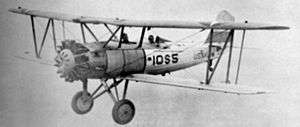Devil Dogs of the Air
| Devil Dogs of the Air | |
|---|---|
 Theatrical poster | |
| Directed by | Lloyd Bacon |
| Produced by |
Hal B. Wallis Jack L. Warner (Executive producer) Lou Edelman (Associate producer) |
| Written by |
Malcolm Stuart Boylan Earl Baldwin John Monk Saunders (original story) |
| Starring |
James Cagney Pat O'Brien |
| Music by | Leo F. Forbstein |
| Cinematography | Arthur Edeson |
| Edited by | William Clemens |
| Distributed by | Warner Bros. |
Release dates | February 9, 1935 |
Running time | 86 (90) minutes |
| Country | United States |
| Language | English |
| Budget | $350,000 (estimated) |
Devil Dogs of the Air (a.k.a. Flying Marines) is a 1935 Warner Bros. film, directed by Lloyd Bacon and starring James Cagney and Pat O'Brien, reprising their earlier roles as buddies after making their debut as a "buddy team" in Here Comes the Navy.[N 1] Devil Dogs of the Air was the second of nine features that Pat O'Brien and James Cagney made together.[N 2] The film's storyline was adapted from a novel by John Monk Saunders.
Plot
Lieut. Bill Brannigan (Pat O'Brien) invites friend and hotshot pilot Tommy O'Toole (James Cagney), the self-styled "world's greatest aviator", to join the USMC Reserve Aviator training program. O'Toole arrives and promptly starts to move in on Brannigan's love interest, Betty Roberts (Margaret Lindsay), and in typical cocky fashion, antagonizes nearly everyone else. Although not temperamentally suited for the military, O'Toole completes primary training and after surviving an accident, eventually realizes that he is willing to change. After a competition in the air with his friend Brannigan, and for the attentions of Betty, there is a predictable conclusion with O'Toole coming out the victor.
Cast
- James Cagney as Thomas Jefferson "Tommy" O'Toole
- Pat O'Brien as Lieut. William R. "Bill" Brannigan
- Margaret Lindsay as Betty Roberts
- Frank McHugh as "Crash" Kelly
- John Arledge as "Mac" Macintosh
- Helen Lowell as Ma Roberts
- Robert Barrat as Commandant
- Russell Hicks as Captain
- William B. Davidson (as William Davidson) as Adjutant, a captain
- Ward Bond as Jimmy, senior instructor
- Bill Elliott (as Gordon Elliott) as Instructor

Production
Principal photography starting on October 1, 1934, was based at the US Naval Base San Diego. Paul Mantz did the aerial stunts for Cagney. One of the featured squadrons stationed there, Marine Attack Squadron 231 (VMA-231) after returning to San Diego in 1928, had traded in its World War I-era O2B-1s for new Curtiss F8C-1s and F8C-3s, which were soon redesignated OC-1s and OC-2s. Equipped with Vought O3U-6 Corsairs, the squadron continued to operate from San Diego and participated in the annual Fleet Problems, operating from the carriers USS Langley, USS Ranger, and USS Saratoga at different times. Shortly after receiving the F8C/OCs, the squadron, along with VO-10M took part in the filming of the 1929 movie Flight and later, prominently appeared in the Devil Dogs of the Air.
The rare U.S. Marine Corps Curtiss RC-1 air ambulance, A-8864, made an appearance in the film.[1] Other unusual types that appear in the film include:
- Loening OL-8 two-seat amphibian biplane
- Travel Air D-4000 civilian stunt biplane
- Vought O2U Corsair two-seat scout biplane
- Boeing F4B single-seat pursuit biplane
- Ford Trimotor multi-passenger transport
- Douglas Dolphin[2]
Maneuvers (wargames) by the United States Navy and the USMC are the actual "stars" of the movie. In the film, the USN represented the BLUE Force while the enemy was the BROWN Force. [N 3]
Reception
Released in an era of patriotic films with overt propaganda themes that set the scene for war preparations, Devil Dogs of the Air received a mildly appreciative public acceptance.[3] Although it had a major release in 1935, the film was re-released in 1941, just before America's entry into World War II, again finding a receptive audience.[4] Critic Leonard Maltin described it as a "tiresome potboiler with Marine Air Corps rivalry between Cagney and O'Brien. Their personalities and good stunt-flying scenes are the only saving grace."[5] Mainly considered hackneyed, it was best considered an aviation film and today, represents an authentic look at the period.[2]
References
- Notes
- Citations
- ↑ "Curtiss K through Z." Aerofiles. Retrieved: March 20, 2011.
- 1 2 Brooks, Marcus. "Aviation Movie: Devil Dogs of the Air." Area 42, December 13, 2010. Retrieved: March 20, 2011.
- ↑ Beck, Sanderson. "Devil Dogs of the Air." Movie Mirrors, 2001. Retrieved: 20 March 2011.
- ↑ Erickson, Hal. "Review: Devil Dogs of the Air." AllMovie GUide, 2011. Retrieved: March 20, 2011.
- ↑ "Review." TCM. Retrieved: March 20, 2011.
- Bibliography
- Dolan, Edward F. Jr. Hollywood Goes to War. London: Bison Books, 1985. ISBN 0-86124-229-7.
- Hardwick, Jack and Ed Schnepf. "A Viewer's Guide to Aviation Movies". The Making of the Great Aviation Films, General Aviation Series, Volume 2, 1989.
- Orriss, Bruce. When Hollywood Ruled the Skies: The Aviation Film Classics of World War II. Hawthorne, California: Aero Associates Inc., 1984. ISBN 0-9613088-0-X.
- Rottman, Gordon L. U.S. Marine Corps World War II Order of Battle: Ground and Air Units in the Pacific War, 1939 - 1945.. Westport, Connecticut: Greenwood Press, 2002. ISBN 0-313-31906-5.
- Sherrod, Robert. History of Marine Corps Aviation in World War II. Washington, D.C.: Combat Forces Press, 1952.
External links
- Devil Dogs of the Air at the Internet Movie Database
- Turner Classic Movies: Devil Dogs of the Air
- Devil Dogs of the Air at AllMovie